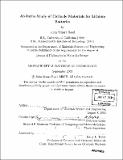Ab-initio study of cathode materials for lithium batteries
Author(s)
Reed, John Stuart, 1968-
DownloadFull printable version (22.02Mb)
Other Contributors
Massachusetts Institute of Technology. Dept. of Materials Science and Engineering.
Advisor
Gerbrand Ceder.
Terms of use
Metadata
Show full item recordAbstract
Using first principles calculations the effect of electronic structure on the stability of positive electrode materials for lithium rechargeable batteries is investigated. The investigation focuses upon lithiated α-NaFeO₂ type 3d transition metal oxide structures. It is found that the ligand field stabilization energy (LFSE) is of particular importance in stabilizing the α-NaFeO₂ type layered structure with general formula Li[sub]x MO₂ (0 <[or equal to] x <[or equal to] 1 and M = Co, Fe, Mn, Ni, ...) at partial lithiation. The key quantity is found to be the difference in LFSE between the 3d metal ion in tetrahedral coordination and octahedral coordination in the cubic close packed (CCP) oxygen framework. If the change in LFSE is small, then the migration of 3d transition metal ions between tetrahedral and octahedral sites generally involves less variation in energy, and hence is easier. This facilitates diffusion of the 3d transition metal ions through the CCP oxygen framework and tends to destabilize the layered structure at partial lithiation. Layered lithium manganese oxide is given particular attention as a material that rapidly transforms to a spinel-like structure with electrochemical cycling. Focus is also placed upon layered lithium cobalt oxide as a material that remains stable in the layered structure with electrochemical cycling. The differing stability of these compounds in the layered structure is explained in terms of LFSE. Spin pairing energy (SPE) is also found to make an important contribution to the energetics of low spin transition metal oxides like lithium cobalt oxide. The influence of SPE on structural stability, as well as other aspects of transition metal electronic structure, are addressed as well. The importance of LFSE, and hence valence, on the stability of the layered structure recommends various doping strategies. In the case of lithium manganese oxide it is found that dopants which decrease the filling of the Mn e[sub]g orbitals stabilize Mn in octahedral coordination, and hence stabilize the layered structure. Dopants which produce this effect are identified as low charge fixed valence ions like Li+, A1³+, Mg²+, or elements with greater electronegativity than Mn³+ such as Ni²+, Co³+, or Cr³+.
Description
Thesis (Ph. D.)--Massachusetts Institute of Technology, Dept. of Materials Science and Engineering, 2003. Includes bibliographical references (p. 303-311).
Date issued
2003Department
Massachusetts Institute of Technology. Department of Materials Science and EngineeringPublisher
Massachusetts Institute of Technology
Keywords
Materials Science and Engineering.